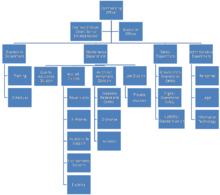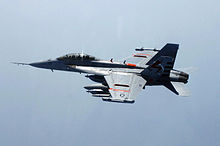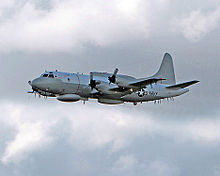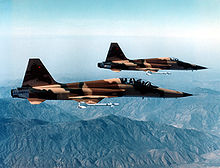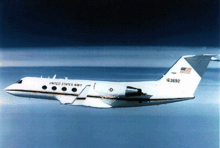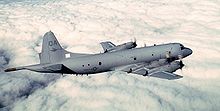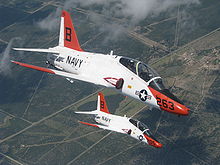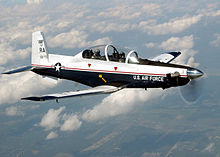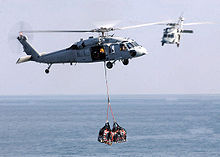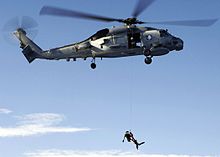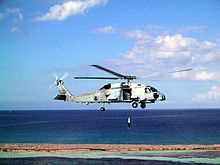- List of United States Navy aircraft squadrons
-
This is a list of United States Navy aircraft squadrons. Deactivated or disestablished squadrons are listed in the List of Inactive United States Navy aircraft squadrons. Navy aircraft squadrons are typically composed of several aircraft (from as few as two to as many as several dozen), the officers who fly them and the men and women that maintain them. Most squadrons also have a number of other administrative support personnel. Some of the activities listed are not technically "squadrons", but they all operate U.S. Navy aircraft in some capacity.
Contents
Squadron organization
Squadrons are typically commanded by a Commander. Second in command is the Executive Officer (XO), also a Commander. The XO typically assumes command of the squadron after approximately 15 months. There are typically four functional departments - Operations, Maintenance, Safety, and Administration - each led by a Lieutenant Commander. Within the departments are Divisions (each typically headed by a Lieutenant) and Branches (headed by a Chief Petty Officer).
Types of squadrons
Navy aircraft are classified by Type (rotary wing, fixed wing), Model (e.g. H-60), and Series (e.g., SH-60B vs HH- 60H).
Squadrons can be categorized in a number of ways: Active versus Navy Reserve, land-based versus sea-based, fixed wing versus rotary wing (helicopter) vs Unmanned aerial vehicle (UAV), and by mission. Unlike the USAF, the US Navy does not typically refer to other organizations (such as maintenance or medical units) as “squadrons”. An exception to this is that US Navy destroyers and submarines are administratively grouped by “squadrons”.
Active squadrons are those in the regular US Navy. Reserve squadrons are in the US Navy Reserve and are manned by reservists. For the most part, there is no way to know by the squadron's name alone whether it is an active or reserve squadron. There are Reserve elements of many Active squadrons, and active duty personnel serving in many Reserve squadrons. In general, reserve squadrons share the same missions as their active counterparts, although there are Reserve missions (e.g., Adversary and Fleet Logistics Support) that have no Active counterpart.
The US Navy has approximately 600 aircraft that are associated with particular ships. There are several hundred Navy aircraft that are capable of shipboard operations, but are not associated with a ship. The Navy also has several hundred land-based aircraft that are not capable of shipboard operations.
Squadrons are listed here by type (fixed/rotary wing) and by mission.
Squadron names
Navy aircraft squadrons can be properly referred to by three different names. The names can give an indication of the squadron’s mission and type of aircraft.
- The ‘’’Formal name’’’ (e.g., Strike Fighter Squadron EIGHT SIX) indicates the mission.
- The ‘’’Informal name’’’ (e.g., VFA-86) also indicates the type and mission, as each of the letters has a meaning. In this case, "V" stands for fixed wing, "F" stands for fighter, and "A" stands for attack.
- Nickname – e.g., "Sidewinders”.
Fixed Wing Squadrons
Most Navy fixed wing squadron informal names start with the letter "V". A notable exception to this rule was the use of "RVAH" to denote Reconnaissance Attack Squadrons which operated the RA-5C Vigilante during the 1960's and 1970's.
Carrier Tactical Electronic Warfare
A typical Tactical Electronic Warfare Squadron consists of four EA-6B Prowlers. The primary mission of the Prowler is Electronic Attack (EA), also known as Suppression of Enemy Air Defenses (SEAD) in support of strike aircraft and ground troops by interrupting enemy electronic activity and obtaining tactical electronic intelligence within the combat area. Navy Electronic Attack squadrons carry the letters VAQ (V-fixed wing, A-attack, Q-electronic). Most VAQ squadrons are carrier based, however a number are "expeditionary", deploying to overseas land bases.When not deployed (either on land or carrier) are home-ported at NAS Whidbey Island. . Two exceptions are VAQ-136 (forward deployed to NAF Atsugi, Japan) and Reserve VAQ-209 based at Andrews AFB, Md [1]
Squadron Name Insignia Nickname Aircraft Notes VAQ-129 
Vikings EA-6B
EA-18GFleet Replacement Squadron
NAS Whidbey IslandVAQ-130 
Zappers EA-6B CVW-3 VAQ-131 
Lancers EA-6B CVW-2 VAQ-132 
Scorpions EA-18G Expeditionary VAQ-133 
Wizards EA-6B CVW-9 VAQ-134 
Garudas EA-6B CVW-17 VAQ-135 
Black Ravens EA-18G Expeditionary VAQ-136 
Gauntlets EA-6B CVW-5 VAQ-137 
Rooks EA-6B CVW-1 VAQ-138 
Yellowjackets EA-18G Expeditionary VAQ-139 
Cougars EA-6B CVW-14 VAQ-140 
Patriots EA-6B CVW-7 VAQ-141 
Shadowhawks EA-18G CVW-8 VAQ-142 
Gray Wolves EA-6B Expeditionary VAQ-209 
Star Warriors EA-6B Reserve Tactical Support Wing Andrews AFB Carrier Airborne Early Warning
Each Carrier Airborne Early Warning squadron usually consists of four E-2C Hawkeyes, The Hawkeye's primary mission is to provide all-weather airborne early warning, airborne battle management and command and control (C2) functions for the Carrier Strike Group and Joint Force Commander. Additional missions include surface surveillance coordination, air interdiction, offensive and defensive counter air control, close air support coordination, time critical strike coordination, search and rescue airborne coordination and communications relay. The E-2 Hawkeye and C-2 Greyhound are built on the same airframe and have many similar characteristics. For this reason, both airframes are trained for in the same Fleet Replacement Squadron.[2]
Squadron Name Insignia Nickname Aircraft Notes VAW-77 Nightwolves E-2C Reserve Tactical Support Wing
JRB New OrleansVAW-112 
Golden Hawks E-2C CVW-9 VAW-113 
Black Eagles E-2C CVW-14 VAW-115 
Liberty Bells E-2C CVW-5 VAW-116 
Sun Kings E-2C CVW-2 VAW-117 
Wallbangers E-2C CVW-11 VAW-120 
Grey Hawks E-2C
C-2Fleet Replacement Squadron
NS NorfolkVAW-121 
Blue Tails E-2C CVW-17
NAS NorfolkVAW-123 
Screwtops E-2C CVW-1
NAS NorfolkVAW-124 
Bear Aces E-2C CVW-8
NAS NorfolkVAW-125 
Tigertails E-2C CVW-7
NAS NorfolkVAW-126 
Seahawks E-2C CVW-3
NAS NorfolkStrike Fighter
A Strike Fighter Squadron is usually made up of ten to twelve F/A-18 Hornets or F/A-18E/F Super Hornets. The Hornet is an all-weather aircraft that is used for attack and fighter missions. In its fighter mode, the F/A-18 is used primarily as a fighter escort and for fleet air defense; in its attack mode, it is used for force projection, interdiction and close and deep air support. The F/A-18 is also used for SEAD and aerial refueling.[3]
Super Hornet
"F/A-18 Hornet strike fighter". USN Fact File. United States Navy. http://www.navy.mil/navydata/fact_display.asp?cid=1100&tid=1200&ct=1.
Squadron Name Insignia Nickname Aircraft Notes VFA-2 
Bounty Hunters FA-18F CVW-2
NAS LemooreVFA-11 
Red Rippers FA-18F CVW-1
NAS OceanaVFA-14 
Tophatters FA-18E CVW-9
NAS LemooreVFA-22 
Fighting Redcocks FA-18F CVW-17
NAS LemooreVFA-27 
Royal Maces FA-18E CVW-5
NAF AtsugiVFA-31 
Tomcatters FA-18E CVW-8
NAS OceanaVFA-32 
Swordsmen FA-18F CVW-3
NAS OceanaVFA-41 
Black Aces FA-18F CVW-9
NAS LemooreVFA-81 
Sunliners FA-18E CVW-17
NAS OceanaVFA-102 
Diamondbacks FA-18F CVW-5
NAF AtsugiVFA-103 
Jolly Rogers FA-18F CVW-7
NAS OceanaSquadron Name Insignia Nickname Aircraft Notes VFA-105 
Gunslingers FA-18E CVW-3
NAS OceanaVFA-106 
Gladiators FA-18A/B/C/D/E/F Fleet Replacement Squadron
NAS OceanaVFA-115 
Eagles FA-18E CVW-5
NAF AtsugiVFA-122 
Flying Eagles FA-18A/B/C/D/E/F Fleet Replacement Squadron
NAS LemooreVFA-136 
Knighthawks FA-18E CVW-1
NAS OceanaVFA-137 
Kestrels FA-18E CVW-2
NAS LemooreVFA-143 
Pukin' Dogs FA-18E CVW-7
NAS OceanaVFA-147 
Argonauts FA-18E CVW-14
NAS LemooreVFA-154 
Black Knights FA-18F CVW-14
NAS LemooreVFA-195 Dambusters FA-18E CVW-5
NAF AtsugiVFA-211 
Checkmates FA-18F CVW-1
NAS OceanaVFA-213 
Black Lions FA-18F CVW-8
NAS OceanaLegacy Hornet
"F/A-18 Hornet strike fighter". USN Fact File. United States Navy. http://www.navy.mil/navydata/fact_display.asp?cid=1100&tid=1200&ct=1.
Squadron Name Insignia Nickname Aircraft Notes VFA-15 
Valions FA-18C CVW-8
NAS OceanaVFA-25 
Fist of the Fleet FA-18C CVW-14
NAS LemooreVFA-34 
Blue Blasters FA-18C CVW-2
NAS OceanaVFA-37 
Ragin Bulls FA-18C CVW-3
NAS OceanaVFA-83 
Rampagers FA-18C CVW-7
NAS OceanaVFA-86 
Sidewinders FA-18C CVW-11
NAS LemooreVFA-87 
Golden Warriors FA-18A+ CVW-8
NAS OceanaVFA-94 
Mighty Shrikes FA-18C UDP
MCAS IwakuniSquadron Name Insignia Nickname Aircraft Notes VFA-97 
Warhawks FA-18C CVW-11
NAS LemooreVFA-113 
Stingers FA-18C CVW-17
NAS LemooreVFA-125 
Rough Raiders FA-18A/B/C/D Fleet Replacement Squadron
NAS LemooreVFA-131 
Wildcats FA-18C CVW-7
NAS OceanaVFA-146 
Blue Diamonds FA-18C CVW-9
NAS LemooreVFA-151 
Vigilantes FA-18C CVW-2
NAS LemooreVFA-192 
Golden Dragons FA-18C CVW-9
NAS LemooreFleet Air Reconnaissance
Fleet Air Reconnaissance squadrons 1 and 2 are the Navy's only land-based signals intelligence (SIGINT) reconnaissance squadrons. The 13 aircraft in the Navy's inventory are based on the Orion P-3 airframe and provide fleet and theater commanders worldwide with near real-time tactical SIGINT. With sensitive receivers and high-gain dish antennas, the EP-3E exploits a wide range of electronic emissions from deep within targeted territory. Fleet Air Reconnaissance squadrons 3, 4, and 7 provide communications relay and strategic airborne command post missions. They provide survivable, reliable, and endurable airborne command, control, and communications between the National Command Authority (NCA) and U.S. strategic and non-strategic forces. The TACAMO ("Take Charge and Move Out") mission links the NCA with naval ballistic missile submarine forces during times of crisis. The aircraft carries a very low frequency communication system with dual trailing wire antennae. The E-6B is a dual-mission aircraft, capable of fulfilling the airborne strategic command post mission and is equipped with an airborne launch control system (ALCS), which is capable of launching U.S. land based intercontinental ballistic missiles.[4]
Squadron Name Insignia Nickname Aircraft Notes VQ-1 
World Watchers EP-3E NAS Whidbey Island VQ-2 
Sandemen EP-3E NAS Whidbey Island VQ-3 
Ironman E-6B Tinker AFB VQ-4 
Shadows E-6B Tinker AFB VQ-7 
Roughnecks EC-18 Training Unit, Tinker AFB Fleet Fighter Composite
Fleet Fighter Composite squadrons provide adversary simulation for fleet squadrons. All VFC squadrons are from the Navy Reserve.
Squadron Name Insignia Nickname Aircraft Notes VFC-12 
Omars FA-18 Reserve
NAS OceanaVFC-13 
Saints F-5 Reserve
NAS FallonVFC-111 
Sundowners F-5 Reserve
NAS Key WestFleet Logistics Support
Fleet Logistics Support squadrons operate Navy unique airlift aircraft on a worldwide basis to provide responsive, flexible, and rapidly deployable air logistics support required to sustain combat operations from the sea. During peacetime, squadrons provide air logistics support for all Navy commands as well as provide continuous quality training for mobilization readiness. Feet Logistics Support squadrons have no counterpart in the Regular Navy. They represent 100% of the Navy’s medium and heavy intra-theater airlift, and operate year-round, around the world providing the critical link between deployed sea going units and air mobility command logistics hubs. VR-1 provides dedicated airlift support to the Office of the Secretary of the Navy, Chief of Naval Operations and Commandant of the Marine Corps. All VR squadrons are from the Navy Reserve.
Squadron Name Insignia Nickname Aircraft Notes VR-1 
Star Lifters C-20D
C-37BReserve
Andrews AFBVR-46 
Eagles C-9 Reserve
NAS Atlanta
to JRB Fort Worth in 2009VR-48 
Capital Skyliners C-20G Reserve
Andrews AFBVR-51 
Windjammers C-20G Reserve
MCAF Kaneohe BayVR-52 
Taskmasters C-9 Reserve
NAS Willow GroveReserve
[Relocated to McGuire AFB, NJ in Mar 2011]VR-53 
Capital Express C-130 Reserve
Andrews AFBVR-54 
Revelers C-130 Reserve
JRB New OrleansVR-55 
Minutemen C-130 Reserve
NAS Point MuguVR-56 
Globemasters C-9 Reserve
NAS OceanaVR-57 
Conquistadors C-40 Reserve
NAS North IslandVR-58 
Sunseekers C-40 Reserve
NAS JacksonvilleVR-59 
Lone Star Express C-40 Reserve
JRB Fort WorthVR-61 
Islanders C-9 Reserve
NAS Whidbey IslandVR-62 
Nomads C-130 Reserve
NAS JacksonvilleVR-64 
Condors C-130 Formerly VP-64, Redesignated 18 September 2004
Reserve
NAS Willow GroveReserve
[Relocated to McGuire AFB, NJ in Mar 2011]Carrier Fleet Logistics Support
There are two Carrier Fleet Logistic Support squadrons - one on each coast. VRC-30 is based at Naval Air Station North Island, VRC-40 is based at Naval Station Norfolk. These squadrons send two-plane detachments with each deploying aircraft carrier. The C-2A Greyhound, more commonly referred to as a "COD" (short for Carrier onboard delivery), is used to deliver high priority parts, supplies, people, and mail to/from the carrier and shore sites near the carrier operating area.
Squadron Name Insignia Nickname Aircraft Notes VRC-30 
Providers NAS North Island VRC-30 Det 1 
Providers C-2 CVW-14 VRC-30 Det 2 
Providers C-2 CVW-2 VRC-30 Det 3 
Providers C-2 CVW-11 VRC-30 Det 4 
Providers C-2 CVW-9 VRC-30 Det 5 
Providers C-2 CVW-5 Squadron Name Insignia Nickname Aircraft Notes VRC-40 Det 1 
Rawhides C-2 CVW-3 VRC-40 Det 2 
Rawhides C-2 CVW-1 VRC-40 Det 3 
Rawhides C-2 CVW-7 VRC-40 Det 4 
Rawhides C-2 CVW-17 VRC-40 Det 5 
Rawhides C-2 CVW-8 Patrol
Maritime patrol aircraft are used primarily for reconnaissance, anti-surface warfare and anti-submarine warfare.
Squadron Name Insignia Nickname Aircraft Notes VP-1 
Screaming Eagles P-3C NAS Whidbey Island VP-4 
Skinny Dragons P-3C MCAS Kaneohe Bay VP-5 
Mad Foxes P-3C NAS Jacksonville VP-8 
Tigers P-3C NAS Jacksonville VP-9 
Golden Eagles P-3C MCAS Kaneohe Bay VP-10 
Lancers P-3C NAS Jacksonville VP-16 
War Eagles P-3C NAS Jacksonville VP-26 
Tridents P-3C NAS Jacksonville VP-30 
Pro’s Nest P-3C FRS
NAS JacksonvilleVP-40 
Fighting Marlins P-3C NAS Whidbey Island VP-45 
Pelicans P-3C NAS Jacksonville VP-46 
Grey Knights P-3C NAS Whidbey Island VP-47 
Golden Swordsmen P-3C MCAS Kaneohe Bay VP-62 
Broadarrows P-3C Reserve
NAS JacksonvilleVP-69 
Totems P-3C Reserve
NAS Whidbey IslandVPU-1 [1] Old Buzzards P-3C NAS Jacksonville VPU-2 [2] Wizards P-3C MCAS Kaneohe Bay Training
There are three types of fixed wing training squadrons - Primary, Intermediate, and Advanced - that train Student Naval Aviators to become United States Naval Aviators and Naval Flight Officers in the Navy, Marine Corps, and Coast Guard. Some United States Air Force pilots are also trained in Navy squadrons. Likewise, some Student Naval Aviators receive some of their training at USAF training squadrons. Navy training aircraft are typically painted orange and white.
Squadron Name Insignia Nickname Aircraft Notes VT-2 
Doerbirds T-34 Primary
NAS Whiting FieldVT-3 
Red Knights T-6B Primary
NAS Whiting FieldVT-4 
Warbucks T-6A
T-39
T-1ANFO Primary/Intermediate
NAS PensacolaVT-6 
Shooters T-6B Primary
NAS Whiting FieldVT-7 
Eagles T-45 Intermediate Tailhook, Advanced Jet
NAS MeridianVT-9 
Tigers T-45 Intermediate Tailhook, Advanced Jet
NAS MeridianVT-10 
Wildcats T-6A
T-1ANFO Primary/Intermediate
NAS PensacolaVT-21 
Redhawks T-45 Intermediate Tailhook, Advanced Jet
NAS KingsvilleVT-22 
Golden Eagles T-45 Intermediate Tailhook, Advanced Jet
NAS KingsvilleVT-27 
Boomers T-34 Primary
NAS Corpus ChristiVT-28 
Rangers T-34 Primary
NAS Corpus ChristiVT-31 
Wise Owls T-44 Advanced Multi-engine
NAS Corpus ChristiVT-35 
Stingrays TC-12 Advanced Multi-engine
NAS Corpus ChristiVT-86 
Sabrehawks T-39
T-45CNFO Advanced Jet
NAS PensacolaOther
Some of these organizations are not technically "squadrons", however they have custody of, and routinely fly navy aircraft.
Squadron Name Insignia Nickname Aircraft Notes Navy Flight Demonstration Squadron 
Blue Angels FA-18
C-130NAS Pensacola Naval Strike and Air Warfare Center 
Strike U
Topgun
TopdomeFA-18
F-16
E-2C
MH-60SNAS Fallon Strike Fighter Weapons School Pacific 
T-34 Mentor NAS Lemoore Pacific Missile Range Facility S-3B Barking Sands Helicopter Squadrons
US Navy helicopters are used for antisubmarine warfare, antisurface warfare, mine warfare, combat search and rescue, special operations, and vertical replenishment missions. The USN helicopter community, in accordance with the "Helicopter Master Plan", is currently undergoing a transformation to reduce costs and infrastructure. The plan calls for expanding warfighting capabilities, modernizing the force, necking down from eight to three aircraft types, and consolidating force structure where possible. This plan is also leading to the renaming of many squadrons.[5] All Navy helicopter (or rotary wing) squadrons' informal names start with the letter "H".
Helicopter Mine Countermeasures Squadron
The Mine Countermeasures Squadrons are each made up of 16 MH-53E Sea Dragon helicopters. The primary mission of the Sea Dragon is Airborne Mine Countermeasures (AMCM). The MH-53 can operate from carriers and other warships and is capable of towing a variety of mine hunting/sweeping countermeasures systems.[6] The MH-53E Sea Dragon is also a capable heavy-lift asset, with three powerful turboshaft engines and a maximum take-off weight of 69,750 pounds (31,640 kg). This gives the Sea Dragon the capability to carry an impressive amount of cargo, personnel or equipment over long distances. The Sea Dragon remains in service as the Navy's only heavy-lift helicopter. According to the Navy's Helo Master Plan, the MH-60S is being considered for the Airborne Mine Countermeasures mission.
Squadron Name Insignia Nickname Aircraft Notes HM-14 
Vanguard MH-53E HM-15 
Blackhawks MH-53E Helicopter Anti-Submarine Squadrons
Helicopter Anti-Submarine squadrons are composite squadrons usually made up of four to six SH-60F Seahawks and two to four HH-60H Seahawks. Both Aircraft are Carrier-Based. The SH-60Fs primary mission is Anti-submarine warfare (ASW) defense of the inner zone, which includes detection, classification and destruction of hostile submarines. HH-60Hs primary mission is combat search and rescue (CSAR), Naval Special Warfare support (NSW) and anti-surface warfare (ASUW).[7]
Squadron Name Insignia Nickname Aircraft Notes HS-4 
Black Knights SH-60F
HH-60HCVW-14 HS-5 
Nightdippers SH-60F
HH-60HCVW-7 HS-10 
Warhawks SH-60F
HH-60HFRS
NAS North IslandHS-11 
Dragonslayers SH-60F
HH-60HCVW-1 HS-14 
Chargers SH-60F
HH-60HCVW-5
NAF AtsugiHS-15 
Red Lions SH-60F
HH-60HCVW-17 Helicopter Sea Combat Squadrons
The Sea Combat Squadron combines both the strike capability of the Helicopter Anti-submarine wing and the cargo capability of the Helicopter Combat Support wing into its primary mission. Over the next decade all HC and HS squadrons will transition to Sea Combat Squadrons upon receiving the MH-60S.[8]
Squadron Name Insignia Nickname Aircraft Notes HSC-2 
Fleet Angels MH-60S Formerly HC-2
Formerly HU-2HSC-3 
Merlins MH-60S Formerly HC-3 HSC-6 
Indians MH-60S Formerly HS-6
CVW-11HSC-7 
Dusty Dogs MH-60S Formerly HS-7
CVW-3HSC-8 
Eightballers MH-60S Formerly HS-8
CVW-9HSC-9 Tridents MH-60S Formerly HS-3
CVW-8HSC-12 
Golden Falcons MH-60S Formerly HS-2
CVW-2HSC-21 
Blackjacks MH-60S Formerly HC-11 HSC-22 
Sea Knights MH-60S NS Norfolk HSC-23 
Wild Cards MH-60S NAS North Island HSC-25 
Island Knights MH-60S Formerly HC-5 HSC-26 
Chargers MH-60S Formerly HC-6 HSC-28 
Dragon Whales MH-60S Formerly HC-8 HSC-84 
Red Wolves HH-60H Formerly HCS-4
Reserve and ActiveHSC-85 
Fire Hawks HH-60H Formerly HCS-5/HC-85
Reserve and ActiveHelicopter Anti-Submarine (Light) Squadrons
Anti-Submarine Light squadrons each operate between six and fifteen SH-60B LAMPS III helicopters. The SH-60Bs primary mission is to provide fully mission capable detachments aboard cruisers, destroyers, and frigates assigned to the Fleet. These detachments are an integral part of the ships weapon system, extending the ships under-sea and anti-ship warfare capabilities beyond the horizon. As of 2003 all Helicopter Anti-Submarine (Light) Squadrons are schedule to be redesignated Helicopter Maritime Strike Squadrons. This change will reflect the switch to the MH-60R Seahawk and the squadrons new multi-mission capability.[9]
Squadron Name Insignia Nickname Aircraft Notes HSL-37 
EasyRiders SH-60B MCBH Kaneohe HSL-40 
Airwolves SH-60B FRS
NS MayportHSL-42 
Proud Warriors SH-60B NAS Jacksonville HSL-43 
Battle Cats SH-60B HSL-44 
Swamp Fox SH-60B NAS Jacksonville HSL-45 
Wolfpack SH-60B NAS North Island HSL-46 
Grandmasters SH-60B NS Mayport HSL-48 
Vipers SH-60B HSL-49 
Scorpions SH-60B HSL-51 
Warlords SH-60B NAF Atsugi HSL-60 
Jaguars SH-60B Reserve NS Mayport Helicopter Maritime Strike Squadrons
Helicopter Maritime Strike squadrons operate the MH-60R Seahawk. The first operational fleet squadron to receive the Romeo is HSM-71 in fiscal year 2008. The new squadron designation was created to reflect the MH-60Rs multi-mission capabilities. Eventually all Anti-submarine (Light) squadrons will transition to the MH-60R and be redesignated HSM.[10]
Squadron Name Insignia Nickname Aircraft Notes HSM-41 
Seahawks MH-60R FRS HSM-70 
Spartans MH-60R CVW-8 HSM-71 
Raptors MH-60R CVW-9 HSM-77 
Saberhawks MH-60R First LAMPS deployment aboard carrier[11] Helicopter Training Squadrons
The United States Navy's Helicopter Training Squadrons provide advanced helicopter flight instruction to all Navy, US Marine Corps, and United States Coast Guard helicopter flight students as well as international students from several allied nations. Students who successfully complete the program earn the right to wear the coveted "Wings of Gold."[12]
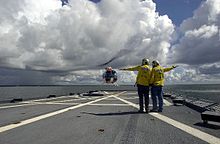 TH-57 training helicopter from HT-8 makes a landing aboard the Navy Helicopter Landing Trainer (HLT) IX-514
TH-57 training helicopter from HT-8 makes a landing aboard the Navy Helicopter Landing Trainer (HLT) IX-514
Squadron Name Insignia Nickname Aircraft Notes HT-8 
Eightballers TH-57 NAS Whiting Field HT-18 
Vigilant Eagles TH-57 NAS Whiting Field HT-28 
Hellions TH-57 NAS Whiting Field UAV Squadrons
Fleet Composite squadrons' primary missions include providing fixed wing and helicopter services to the Fleet in support of the United States and Allied operational training exercises and operating the Navy's only operational Unmanned Aerial Vehicle (UAV). This aircraft is utilized primarily in reconnaissance missions. Tactical employment of this unique asset primarily supports both Battle Group deployments and Amphibious Warfare Operations.[13]
Test and Evaluation
Test and Evaluation squadrons test everything from basic aircraft flying qualities to advanced aerodynamics. VX squadrons report to the Commander, Operational Test and Evaluation Force (OPTEVFOR).
Squadron Name Insignia Nickname Aircraft Notes USN Test Pilot School 
Various NAS Patuxent River VX-1 
Pioneers P-3C
MH-60R
MH-60S
SH-60F
EP-3E
E-6B
KC-130J
E-2C
RQ-4
P-8AEvaluation of airborne
anti-submarine warfare
and maritime anti-surface warfare
weapons
NAS Patuxent River[14]VXS-1 
Warlocks P-3
C-12formerly NRL's Flight Support Detachment
Scientific Development
NAS Patuxent River[14]VX-9 
Vampires FA-18 All Variants
EA-18G
AV-8
EA-6B
AH-1Z
UH-1Y
and other variantsOperational Weapons Test
NAWS China LakeVX-20 
Force E-2C
P-3C
C-130
C-2A
E-6B
T-34CForce Warfare Aircraft Test
NAS Patuxent River[15]HX-21 
Blackjack AH-1Z
UH-1Y
MH-60R
MH-60S
MV-22B
AH-1W
UH-1N
VH-3A
CH-53E
TH-57C
SH-60FRotary Wing Aircraft Test
NAS Patuxent River[16]VX-23 Saltydogs F-35
FA-18
EA-6B
EA-18G
T-45Strike Aircraft Test
NAS Patuxent RiverVX-30 
Bloodhounds C-130
P-3 All Variants
S-3B
FA-18Weapons Test
NAS Point MuguVX-31 
Dust Devils FA-18
EA-18G
NEA-18G
P-3
C-130
AV-8
TAV-8B
T-39
AH-1Z
UH-1Y
and other variantsWeapons Test
NAWS China LakeSee also
- Naval aviation
- List of Disestablished United States Navy Squadrons
- Modern US Navy carrier air operations
- List of military aircraft of the United States (naval) / List of US Naval aircraft
- United States Naval Aviator
- Naval Flight Officer
- United States Marine Corps Aviation
- United States Air Force
- United States Army Aviation Branch
- Military aviation
- NATOPS
References
- ^ The EA-6B will be replaced by the EA-18G Growler. "EA-6B Prowler electronic warfare aircraft". USN Fact File. United States Navy. http://www.navy.mil/navydata/fact_display.asp?cid=1100&tid=900&ct=1.
- ^ "E-2 Hawkeye early warning and control aircraft". USN Fact File. United States Navy. http://www.navy.mil/navydata/fact_display.asp?cid=1100&tid=700&ct=1.
- ^ A, C, and E models are single seat. B, D, and F models are two seat.
- ^ "E-6B Airborne Command Post (ABNCP)". United States Strategic Command. http://www.stratcom.mil/fact_sheets/fact_acp.html.
- ^ "The Helicopter Master Plan". Federation of American Scientists. http://www.fas.org/man/dod-101/navy/docs/vision/helomstr.htm.
- ^ "MH-53E Sea Dragon". USN Fact File. United States Navy. http://www.navy.mil/navydata/fact_display.asp?cid=1200&tid=400&ct=1.
- ^ "SH-60 Seahawk helicopter". USN Fact File. United States Navy. http://www.navy.mil/navydata/fact_display.asp?cid=1200&tid=500&ct=1.
- ^ "Helicopter Sea Combat Wing, Pacific COMHELSEACOMBATWINGPAC". Global Security. http://www.globalsecurity.org/military/agency/navy/helseacombatwingpac.htm.
- ^ "Helicopter Maritime Strike Wing, Pacific". Commander Helicopter Maritime Strike Wing, Pacific. Global Security. http://www.globalsecurity.org/military/agency/navy/hslwingpac.htm.
- ^ "MH-60R Seahawk". USN Fact File. United States Navy. http://www.navy.mil/navydata/fact_display.asp?cid=1200&tid=500&ct=1.
- ^ Utz, Curtis A; Mark L Evans; Dale J Gordon (July-August 2005). "The Year in Review 2004" (PDF). Naval Aviation News (United States Navy): 37. http://www.history.navy.mil/nan/backissues/2000s/2005/julaug/p20-43_Year%20in%20Review%202004.pdf.
- ^ "Helicopter Training Squadron 8". Global Security. http://www.globalsecurity.org/military/agency/navy/ht-8.htm.
- ^ "Fleet Composite Squadron SIX". U.S. Navy. Global Security. http://www.globalsecurity.org/military/agency/navy/vc-6.htm.
- ^ a b "Naval Air Station Patuxent River Base Guide". DCMilitary.com. Comprint Military Publications. 2008-08-12. http://www.dcmilitary.com/special_sections/sw/081206/ss_120846_31938.shtml. Retrieved 2008-12-01.
- ^ "VX-20 Aircraft Platforms". Air Test and Evaluation Squadron TWO ZERO. United States Navy. 2006-06-10. http://www.navair.navy.mil/force/AircraftPg1.htm. Retrieved 2008-12-01.[dead link]
- ^ Carlson, Ted (Spring 2005). "HX-21 - Blackjack". Wings of Gold (Association of Naval Aviation). http://findarticles.com/p/articles/mi_qa3834/is_200504/ai_n15743379. Retrieved 2008-12-01.[dead link]
Categories:- United States Navy aircraft squadrons
- United States Navy lists
- United States naval aviation
- Lists of United States military units and formations
Wikimedia Foundation. 2010.

